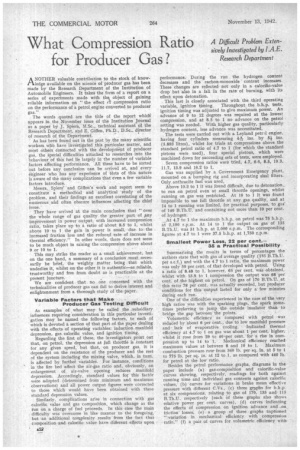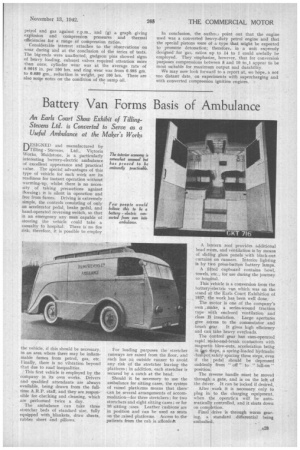What Compression Ratio for Producer Gas?
Page 24

Page 25

If you've noticed an error in this article please click here to report it so we can fix it.
A Difficult Problem Extensively Investigated by I .A.E. Research Department A NOTHER valuable contribution to the stock of know1-1.1edge available on the science of producer gas has been made by the Research Department of the Institution of Automobile Engineers. It takes the form of a report on a series of experiments made with thq object of gaining reliable information on " the effect e'l compression ratio on the performance of a petrol engine converted to producer gas."
The words quoted are the title of the report which appears in the November issue of the Institution Journal as a paper by J. Spier's, M.Sc., technical assistant of the Research Department, and E. Giffen, Ph.D., D.Sc., director of research of the Department.
As has been found out in the past by the many scientific workers whb have investigated this particular matter, and most others connected with the development of producer gas, the special difficulties attached to researches into the behaviour, of this fuel lie largely in the number of variable factors affecting performance. All these have to be sorted Out before any conclusion can be arrived at, and every engineer who has any experience of tests of this nature is aware of the many complications that even a few variable factors introduce.
Messrs. Spiers' and Giffen's work and report seem to constitute a methodical and analytical study of the problem, and their findings an excellent correlating of the numerous and often obscure influences affecting the chief issue.
They have arrived at the main conclusion that " over the whole range of gas quality the greater part of Any improvement in power output, with increased compression ratio, takes place up to a ratio of about 8.5 to 1, whilst above 10 to 1 the gain in power is small, due to the increased friction loss and the reduced .rate of increase in thermal efficiency." In other words, there does not seem to be much object in raising the 'compression above about 9 or 10 to 1.
This may strike the reader as a small, achievement, but on the one hand, a summary of a conclusion must, necessarily be thief, the weighty matter being that which underlies it whilst on the other it is autheritic---as trustworthy and free from doubt as is practicable at the present juncture.
We are confident that no one concerned with the technicalities of producer gas can fail to derive interest and enlightenment from a thorough study of the paper.
Variable Factors that Make Producer Gas Testing Difficult
As examples of what may be called the . subsidiary influences requiring consideration in this particular investigation may be named the following factors, to each of which is devoted a section of that part of the paper dealing with the effects of operating variables: induction manifold depression, gas calorific value, and ignition timing.
Regarding the first of these, the investigators point out that, on petrol, the depression at full throttle is constant for any given speed, but that, on producer gas, it is dependent on the resistance of the producer and the rest of the system including the mixing valve, which, in turn, is affected by furthei variables. For instance, conditions in the fire bed affect the air-gas ratio and, obviously, an enlargement of air-valve opening reduces manifold depression. Accordingly, standard values for this factor were adopted (determined from minimum and maximum observations) and all power output figures were corrected to those which would have been obtained with these standard depression values.
Similarly, complications arise in connection with gas calorific value and gas composition, which change as the run on a charge of fuel proceeds. In this case the main difficulty was overcome in like manner to the foregoing, but .an additional complexity results from the fact that composition and calorific value have different effects upon
22
performance. During the run the hydrogen content decreases and the carbon-monoxide content increases. These' changes are reflected not only in a calorific-value drop but also in a fall in the rate of burning, with its effect upon detonation.
This last is closely associated with the third operating variable, ignition timing. Throughout the b.h.p, tests. ignition timing was adjusted to give maximum power. An advance of 9 to 12 degrees was required at the lowest compression, and at 8.5 to 1 no advance on the petrol setting was needed. With higher gas quality, particularly hydrogen content, less advance was necessitated.
The tests were carried out with a Leyland petrd engine, having four cylinders measuring 412r, ins. by 5f ins. (5.893 litres), whilst for trials at compressions above the standard petrol ratio of 4.7 to 1 (for which the standard pistons were used), four special pistons, which were machined down for succeeding sets of tests, were employed.
Seven compression ratios were tried, 4.7, 6.6, 8.5, 10.3, 11.7, 13.9 and 16.2 to 1. • Gas was supplied by a Government Emergency plant, mounted on a bumping rig and incorporating sisal filters. Only anthracite fuel was used, Above 10.3 to 1 it was found difficult, due to detonation.. to run on petrol even at small throttle openings, whilst running on gas was restricted. At 16 to 1 it was found impossible to use full throttle at any gas quality, and at 14 to 1 running was limited, for practical purposes, to gas' of 140 B.Th.U. and containing not more than 10 per cent. of hydrogen.
At 4.7 to 1 the maximum b.h.p. on petrol was 75 b.h.p. at 2,100 r.p.m. At 14 to 1 the output on gas of 135 B.Th.U. was 51 b.h.p. at 2,000 r.p.rn. The corresponding figures at 4.7 to 1 were 37.5 b.h.p. at 1,750 r.p,m.
Smallest Power Loss, 22 per cent.— _ 35 a Practical Possibility'
Summarizing the results in terms of percentages the authors state that with gas of average quality (195 B.Th.U. per s.c.f.) and with the 4.7 to 1 ratio, the maximum power was only 50 per cent. of that developed with petrol. Using a ratio of 8.48 to 1, however, 65 per cent. was obtained, whilst with 13.9 to 1 compression the output was 68 per cent, of the highest on petrol. On gas of 170 B.Th.U. at this ratio 78 per cent, was actually recorded, but producer conditions for this output lasted for only a few minutes
during each run. • One of the difficulties experienced in 'the case of the very high ratios was with the sparking plugs, the spark sometimes preferring to jump the outside insulator than to bridge the gap between the points.
Volumetric efficiency as compared with petrol reduced by about 6 per cent., due to low manifold pressure
andlack of evaporative cooling. Indicated thermal efficiency at 4.7 to 1 on gas was about 1 per cent. higher, whilst it rose from 29 to 40 per cent, for a rise in com pression up to 14 to 1. Mechanical efficiency reached maximum values at between 8 and 10 to 1. Maximum combustion pressure rose. from 340 lb. per sq. in. at 5 to 1 to 775 lb. per sq. in. at 12 to 1, as compared with 440 lb. for petrol at the low ratio.
Besides the petrol performance graphs, diagrams in the paper include (a) gas-composition and' calorific-value curves showing, respectively, readings for both against running time and individual gas contents against calorific values, (b) curves for variations in brake mean effective pressure with different C.Vs., (c) three graphs for b.h.p. at six compressions, relating to gas of 170, 135 and 115 B.Th.U. respectively (each of these graphs also shows relative power per cent. curves), (d) curves indicating the effects of compression on ignition advance and -on friction' losses, (e) a group of three graphs captioned "variation in mechanical efficiency with compression ratio," (f) a pair of curves for volumetric efficiency with
was petrol and gas against r.p.m., and (g) a graph giving explosion and compression pressures and thermal efficiencies for a range of compression ratios. Considerable interest attaches to the observations on wear during and at the conclusion of the series of tests. The big-ends were unaffected, gudgeon pins showed signs of heavy loading, exhaust valves required attention more than once, cylinder wear was at the average rate of 0.0015 in. per 100 hrs. and ring wear was from 0.595 gm. to 0.689 gm., reduction in weight, per 100 hrs. There are also some notes on the condition of the sump oil.
In conclusion. 1 he atitlio_; point out that the engine used was a converted heavy-duty petrol engine and that the special pistons were of a type that might be expected to promote detonation; therefore, in a unit expressly designed for gas, ratios up to 14 to I could usefully he employed. They emphasize, however, that for conversion purposes compressions between 8 and 10 to.,1 appear to be most suitable for maximum output and durability.
We may now look forward to a report at, we hope,. a not too distant date, on experiments with supercharging and with converted compression ignition engines.




















































